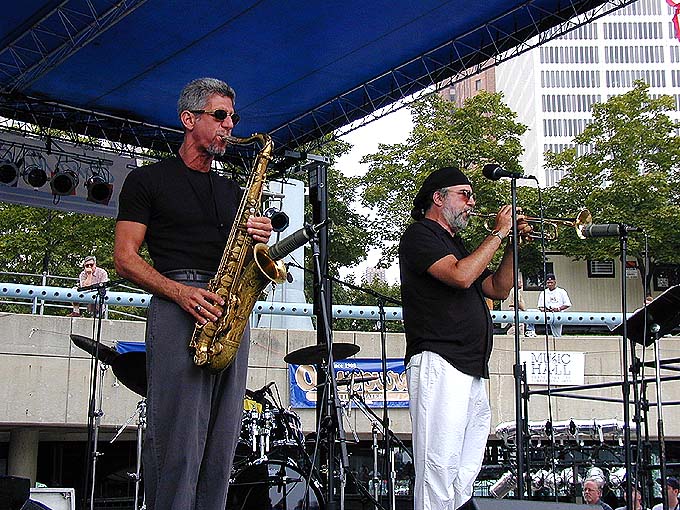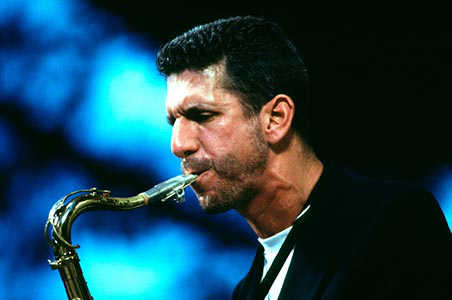07.04. – Happy Birthday !!! Born in 1951, Bob Berg began his musical experience at the age of six, studying classical piano at his home in Brooklyn N.Y. He began playing saxophone at the age of 13, and soon thereafter attended the High School of the Performing Arts. In 1968, Berg was admitted to The Juilliard School, studying classical saxophone. While attending Juilliard, Berg was offered a tour with the organist Jack McDuff, which began his career as a jazz musician.
In 1973, Berg joined Horace Silver’s band and remained there for three years, appearing on three of Silver’s albums. It was in this period that Bob also became active on the New York jazz scene meeting other young musicians and playing and exchanging ideas with many of his peers. It also gave him the opportunity to work with some of the great bands working around the city.
In 1976, he replaced George Coleman in Cedar Walton’s classic quartet, Eastern Rebellion. Berg remained with Walton for five years, playing alongside the legendary rhythm section of bassist Sam Jones and drummer Billy Higgins. With this band, Berg toured the world extensively and recorded many albums.
In 1984, Berg joined the Miles Davis band. His association with Miles lasted three years and consisted of many world tours and several recordings. After leaving Davis, Berg embarked on a solo recording career and a well-known collaboration with guitarist Mike Stern. Bob and Mike produced many recordings together and toured extensively.
In 1992, Berg began his work with Chick Corea’s acoustic Quartet. Again, he has toured the world several times with this great band, also recording two CD’s with the band.
In the nineties Berg was invited to act as a cultural ambassador by the US Department of State. The “Bob Berg Quartet” toured the Caribbean Rim in 1992, and a large portion of the former Soviet Union in1994. The band met with much success in these regions.
Berg has played and recorded with many other great musicians, too numerous to mention. He has recorded ten albums as a leader, which have reflected his rather wide scope of interests in improvisational-based music. In 1993, Berg’s recording “Back Roads” was nominated for a Grammy Award for “best contemporary jazz performance.”
In 1968, he made his professional debut touring behind Brother Jack McDuff, and by the time the 1960s drew to a close, he specialized in tenor saxophone, his subsequent creative path profoundly shaped by John Coltrane. After a brief flirtation with free jazz Berg renounced the avant-garde in favor of postwar bop. On the recommendation of fellow saxophonist Michael Brecker, he joined Silver in 1973, remaining with his boyhood hero for three years, when he replaced George Coleman in Cedar Walton’s Eastern Rebellion. In 1978 Berg stepped out to record his debut LP, New Birth, and after leaving Walton in 1981 he cut his sophomore effort, Steppin’: Live in Europe; he rose to new levels of renown upon joining Miles Davis in 1984, a three-year stint that set the stage for his 1987 breakout session, Short Stories. Berg closed out the decade in the band he led with co-founder/guitarist Mike Stern, cutting a series of LPs including 1988’s Cycles and 1990’s In the Shadows. In 1992, he signed on with Chick Corea’s acoustic quartet, and that same year led his own quartet on a U.S. Department of State-sponsored tour of the Caribbean. Upon releasing the 1997 solo date Another Standard, Berg joined an acoustic reincarnation of the group Steps Ahead, and in 2000 he also joined the cooperative project the Jazz Times Superband, collaborating with Randy Brecker, Joey Defranchesco, and Dennis Chambers. Berg next surfaced alongside vibraphonist Joe Locke in the group 4 Walls of Freedom. Sadly, their eponymous debut set did not appear until after the saxophonist’s death in an auto accident near his home on Long Island on December 5, 2002.
Jazz players tend to be good sharers and good listeners – the qualities are virtually obligatory in often spontaneously conceived ensemble music. And the respect that the best players command can frequently be measured by the behaviour of their fellow professionals in the audience. Bob Berg, the lean, flint-featured American saxophonist, who has died aged 51 in a car accident, often received that kind of attention. The late Ronnie Scott would check Berg out, sitting attentively at a side-table on the American’s visits to his premises.
Berg’s formidable services were also admired and hired by Miles Davis, Chick Corea, Horace Silver and many other leaders who knew that jazz sax players with John Coltrane/Wayne Shorter techniques were becoming a dime a dozen, and the special ones were rare.
Berg’s particular skill was the kind of high-energy, tenor-sax style that became ubiquitous after the 1960s, an avalanche of hard-edged sounds, dissonant high-register brays and a dense, accumulative melodic approach. Berg’s technique, though not the equal of his contemporary Michael Brecker, was good enough to avoid emphasising the idea that any of this was an effort (thereby relieving it of grandstanding effects). He did not hire ciphers, but comparable virtuosi such as the pianist Dave Kikowski, who would help him add complexities and ambiguities to familiar material and recast it. But, like Sonny Rollins (whom he often resembled), Bob Berg’s unaccompanied soliloquies and intros could be among his most remarkable achievements – a little drier and less inclined to quotation and irony than Rollins, but almost as full of heart and surprise.
Bob Berg was born in New York and studied classical piano from the age of six. At junior high school he took up the alto saxophone, fascinated by the music of Charlie Parker and Cannonball Adderley. But in 1966, when he was 15, Berg joined the ranks of countless other budding jazz musicians of the day who took up the tenor sax after hearing John Coltrane’s devotional odyssey A Love Supreme. Berg went to the High School of Performing Arts in New York, and then to the Juilliard School, leaving in late 1969 to work briefly with the Hammond organ jazz-blues bandleader Brother Jack McDuff. However, McDuff’s invigorating but structurally simple, hot-licks jazz failed to stimulate a young player growing increasingly interested in musical challenges.
Advertisement: In the early 1970s, Berg became involved in New York’s “loft movement”, informal jams and relaxed public airings between experimentalists seeking to develop the free-jazz departures of the previous decade. But if Bob Berg was intrigued by the expansion of the saxophone’s vocabulary offered by the free scene, its abandonment of songs, and sometimes regular pulse, eventually lost him. By 1973 he had joined the band of one of the most celebrated conventionally swinging musicians of the pre-free era, pianist Horace Silver.
Berg made three albums with Silver in the mid-1970s, and worked fitfully with drummer Buddy Rich’s big band. Into the early 1980s the saxophonist explored other avenues including salsa, and joined former Art Blakey pianist Cedar Walton’s group Eastern Rebellion.
The big jazz news of those years was the return of Miles Davis to performing after a four-year layoff, with a new hybrid of airplay pop and raw-blowing jazz some dubbed “avant-disco”. Berg had developed a saxophone style ideally suited to a groove-based but melodically freewheeling music, and Davis hired him on the recommendation of drummer Al Foster in 1984. The relationship lasted three years, until Berg eventually found his style cramped by an idiom that only required a part of what he was capable of in improvisational terms. He also surmounted the familiar “personal problems” of the earlier jazz world.
Berg’s recordings were rarely the equal of his public appearances, but he had begun recording under his own name before the Davis stint, making the live album Steppin’ for the Red label, with a European band. From 1986 he was often in the studio with a fellow Miles Davis sideman, guitarist Mike Stern.
The saxophonist also performed with trumpeter Randy Brecker, but a period with pianist Chick Corea helped bring Berg back to a more traditionally acoustic jazz. Signed to Corea’s Stretch label, Berg began to do more justice to his abilities on disc, though his original compositions were not the equal of his improvising. Riddles (1994) revealed a route that might have become promising for him – more emotionally intense and less overtly technical playing on an interesting world music/fusion repertoire – but Another Standard in 1996 was a personal landmark. His dolorous playing on the Beatles’ Michelle, and bleak lyricism on My Man’s Gone Now confirmed a talent coming to maturity. In his recent live performances in Britain, alongside vibraharpist Joe Locke, the saxophonist resoundingly emphasised that he was still discovering his musical core.
He is survived by his wife, Arja, and two children.







More Stories
CD review: George Benson – Dreams Do Come True: When George Benson Meets Robert Farnon – 2024: Video, CD cover
The band was tight as ever. The Warren Haynes Band cuts loose: Video, Photos
Interview with Alvin Queen: Feeling Good – I heard these tunes played by … Video, new CD cover, Photos